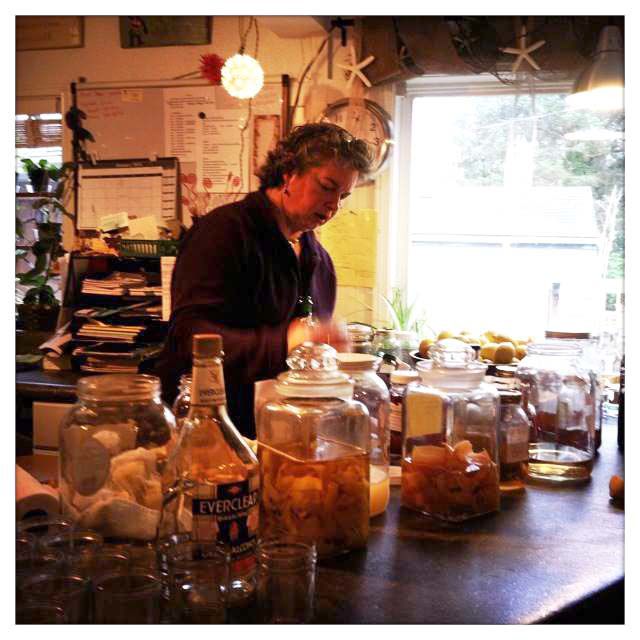When life gives you lemons (or any citrus fruit, really), make limoncello
Published 3:52 am Thursday, January 23, 2014

- <p>Mary Sherman brought several jars of different homemade liqueurs to her limoncello presentation at Back Alley Gardens on Jan. 18.</p>
Sitting in my friends kitchen, I held a lemon in one hand and a vegetable peeler in the other, staring at the skin of the fruit in question that I had just mutilated.
I was trying to peel the yellow skin of the lemon without also shaving off a layer of the bitter white pith underneath. The problem was, peeling the zest of a lemon is easier said than done. (Why wasnt I using a zester? First, there wasnt one to be found, and second, we had a bowl of 20-some lemons to prepare.)
A few hours ago, Mary Sherman had peeled a wide, pith-less strip of skin off a lemon with the speed and ease of practiced hands. Mary, a veteran liqueur maker, was giving a presentation at Back Alley Gardens in Gearhart called When Life Gives You Lemons, Make Limoncello.
We have a rule at our house in the winter, when the fruit is fresh, Mary said about her Portland home. Peel that orange before you eat it! Peel that lemon before you juice it!
The zest of a lemon is what gives limoncello, an Italian lemon liqueur, its flavor.
Though it might appear difficult to make, the process of making limoncello is incredibly simple: All you need is lemons, booze, time and sugar.
First, choose organic fruit you dont want any wax and wash well.
Second, choose your alcohol. You can use vodka or Everclear, which is a high-proof grain alcohol.
Then, set up a method for the spirits to absorb the oils from the lemon skin. During her presentation, Mary touched on the various ways you can do this. Zesting is one option; peeling is another. A third way is an old Italian practice recently popularized by Douglas Derrick, bar manager of Nostrana in Portland, where you suspend lemons in cheesecloth above the alcohol in a large, sealed glass jar. High-proof alcohol volatilizes naturally at room temperature, and in the small world of the jar, the vapors extract the essential oils from the lemon.
Choose your method, placing your lemon choice and alcohol of choice into a clean glass container with a lid. Seal it.
Then, you wait. Some recipes vary on how long to play the patience game anywhere from a few weeks to months.
Youre suspending a fruit in alcohol thats not going to go bad, Mary said about time frames.
She was a proponent of putting it on a shelf with a dated label and forgetting about it. Maybe giving the jar a shake from time to time.
The beauty of it is, it really improves with age, she said. Its better a year from today than six weeks from today.
One way to see if your limoncello is ready is the snap test. Pull a peel out from the mix, and fold it in half: If it breaks, your liqueur is ready. If its still pliable, you should wait awhile and then test again.
After you think the lemon peels have steeped long enough, strain the mixture and remove the peels. Then, add simple syrup. You want it to taste good and be easy to sip.
Marys partner, Oregonian garden writer and photographer Vern Nelson, sat to the side during the presentation, interjecting fruit facts every now and then. While Mary said she preferred a more tart taste to her liqueurs (she also enjoys making homemade drinking vinegars), Vern goes more for the sweet stuff.
Its all about finding what you like and what you dont like, Mary said. Theres really no right or wrong.
At the presentation, there was no end of examples to inspire the amateur liqueur maker. Mary, ever an experimenter, had multiple jars on display (and ready to taste) filled with various homemade cordials. Besides the traditional limoncello, there was a grapefruit liqueur, a pomegranate seed version, a limequat version, and one of different citrus and cranberries. Another jar held dried figs steeped in vodka with a vanilla bean.
One cordial that used a local fruit was a quince liqueur: Cored and grated, the quince was soaking in vodka with cinnamon and cloves. The end product had a rich, apple-like taste with a warm, spiced accent.
Mary also makes a walnut wine using green walnuts from a tree in her yard.
She said she started making her own orange bitters years ago, and the experimenting grew from there.
My friend and I walked away from Back Alley Gardens with minds abuzz with plans of what we should make. We got started that night: A big bag of lemons was gifted our way, so we set to work.
After a few false tries, we started to get the knack of using the peeler on the lemon (delicate, shallow, side-to-side swipes. A word to the wise: Take your time.).
Now, I have a huge jar of lemon peels submerged in equal parts Everclear and vodka sitting on my kitchen counter. It will slowly turn into a lemon liqueur over the next two months. After straining and adding simple syrup, Ill have a homemade limoncello. To give as gifts, add to a cocktail, or enjoy the traditional way chilled, in a small glass, after a fine meal.









